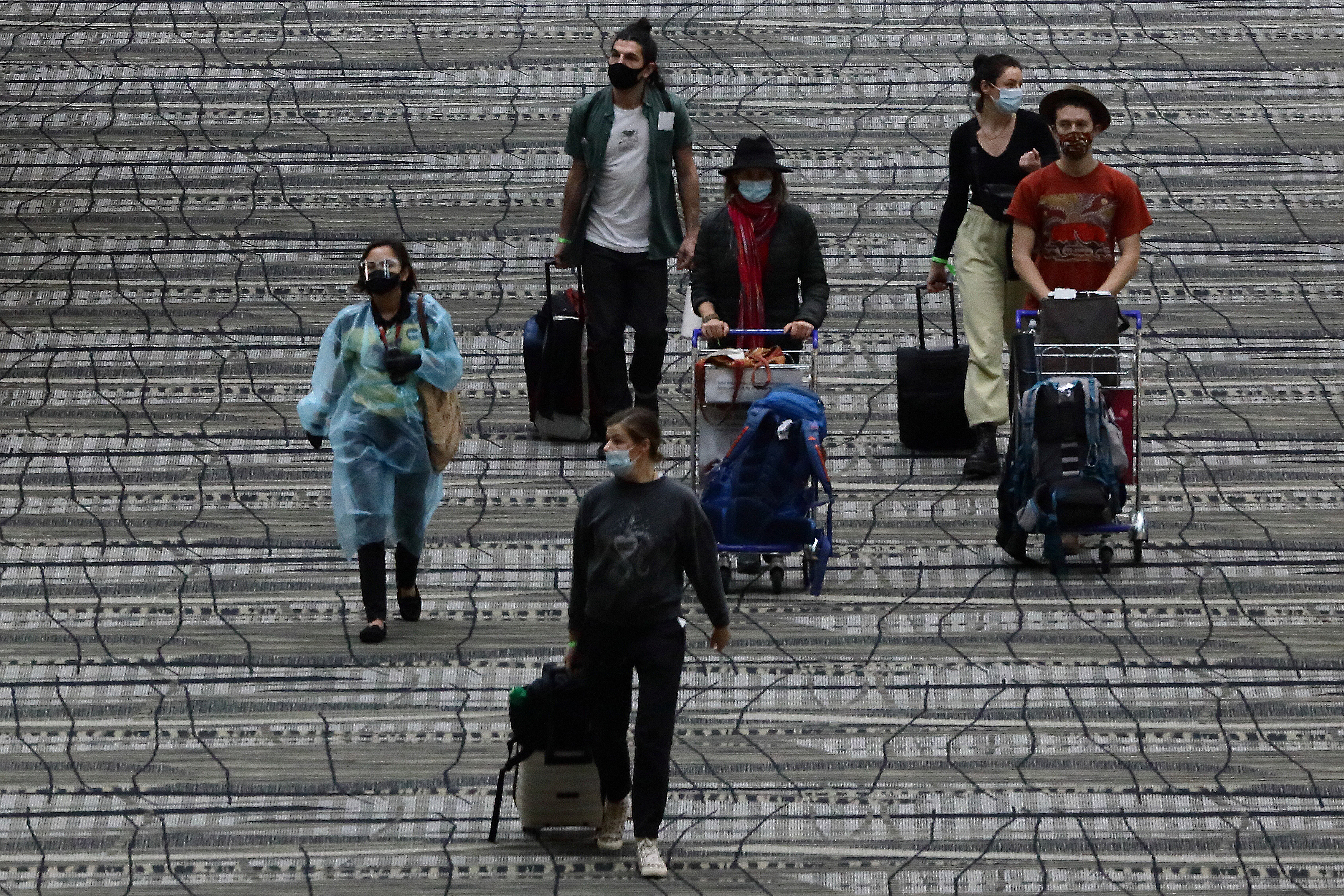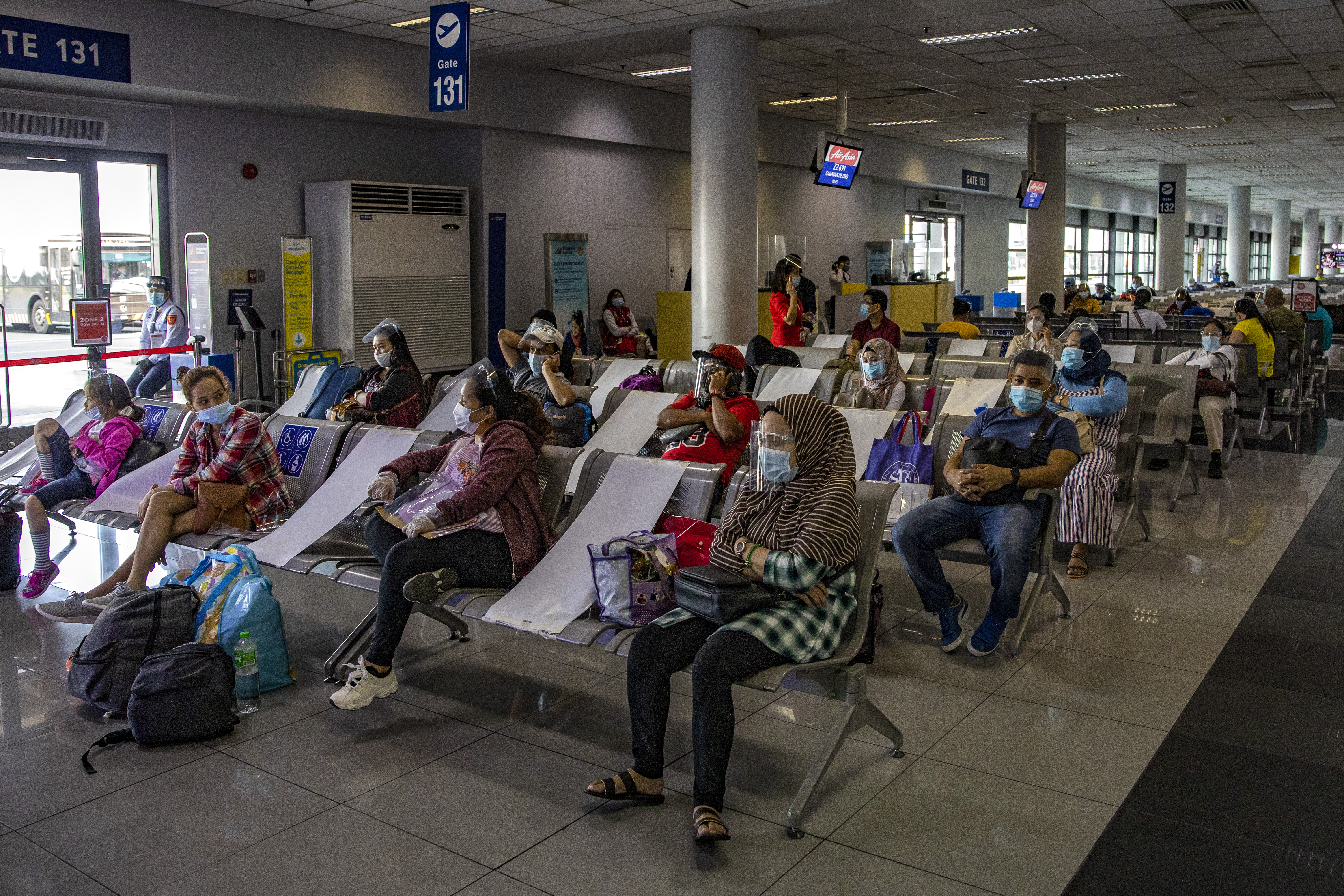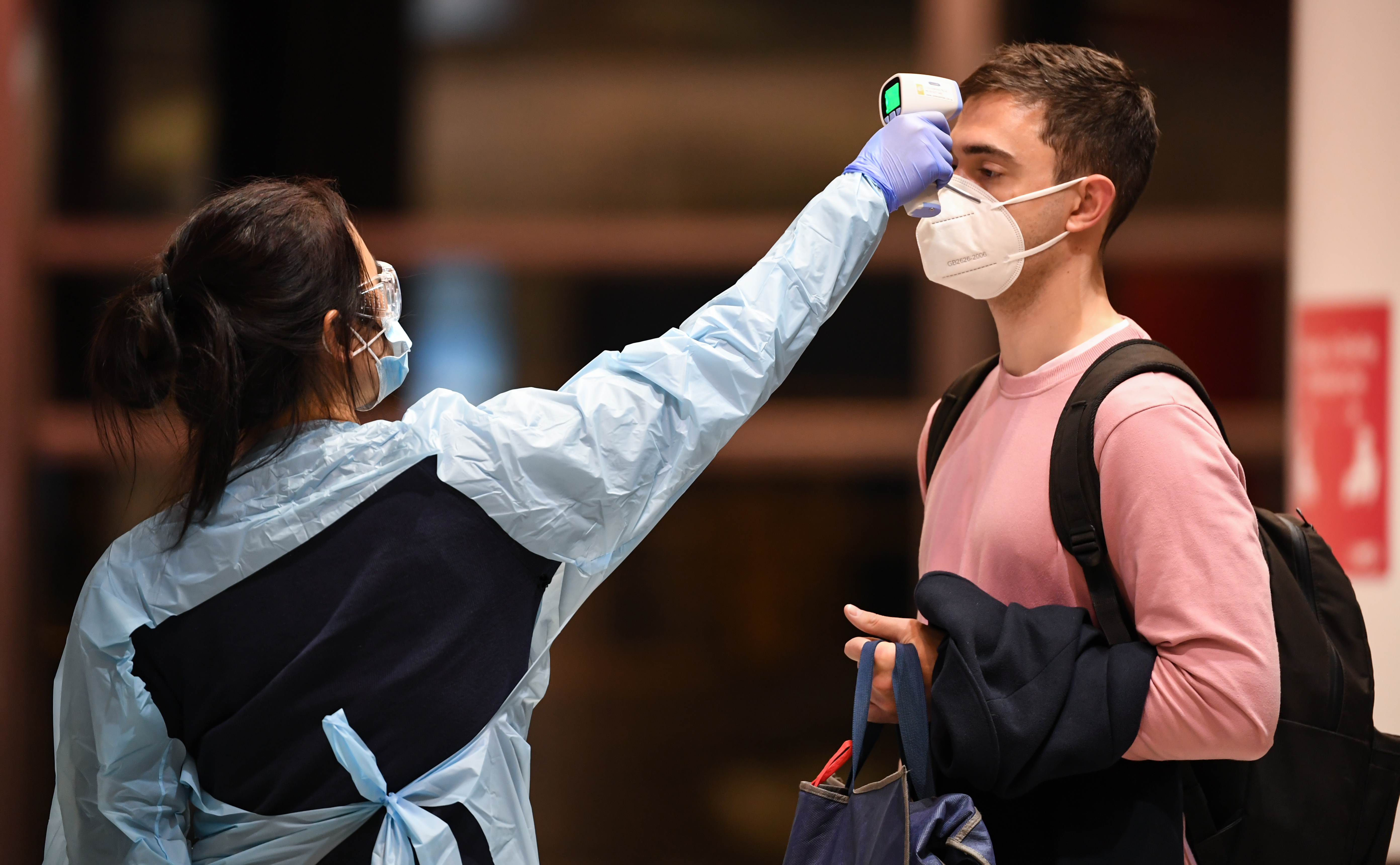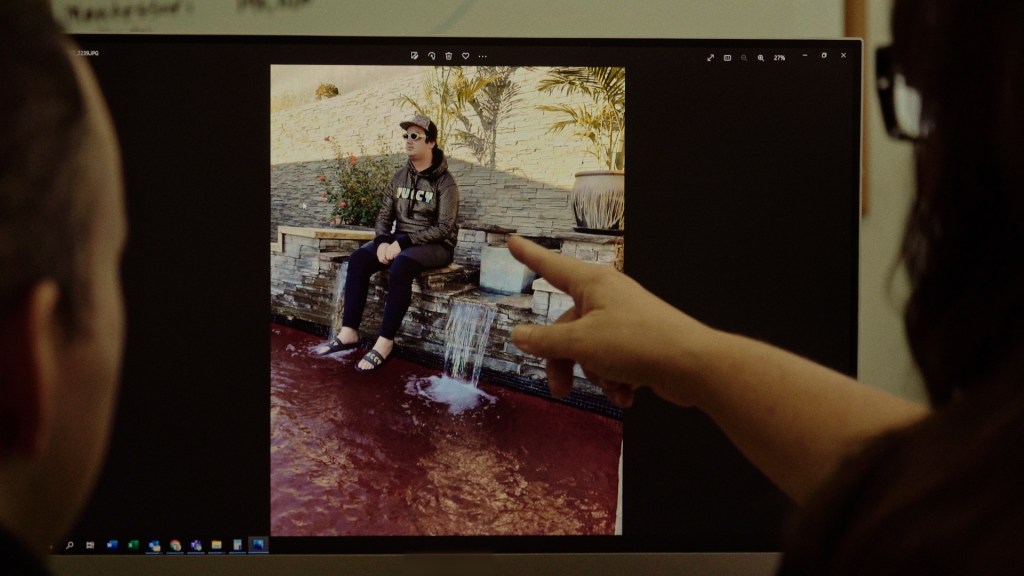This is part of a special series, We’re Reemerging. What Does the World Look Like Now?, which considers in real time how we cope while living through a historic time. It’s also in the latest VICE magazine. Subscribe here.
I reread the results several times to make sure I was seeing correctly: “POSITIVE for SARS-CoV-2 (causative agent of COVID-19).” I had no symptoms, and I had tested negative just three days prior—surely this was a mistake. Besides, I thought, I already have my suitcases packed and my plane ticket booked. This COVID test was meant to just be something to tick off the checklist. How could I possibly be infected?
Videos by VICE
I so refused to believe the test that I insisted on taking another one the next day, hours before my flight, convinced that the previous one was a false positive and that I would still be able to board my plane. The second test reaffirmed the infection, as did the cough that started to creep up that day, which I stifled in rebellion.
Looking back, perhaps it was only a matter of time before my swab test would come back positive. I had hopped around four countries across three continents in just five months amid a global pandemic. I hadn’t meant to travel so widely—most trips were unplanned, forced by circumstances ranging from a family member’s death to travel restrictions—but I did. I found myself on planes every few months, sitting in deserted aircraft cabins, landing in foreign, quiet airports.
I used to adore airports. I loved the promise of new adventures they brought, the chances of reunions they afforded, and the feeling of finally coming home. But over half a year, five landing strips, and 22,906 miles flown later, airports have evolved to represent so much more than borders and entry points. In the middle of a raging pandemic, I see them now as something less emotional and more clinical: Airports are the microcosm of a government’s grasp—or lack thereof—of the virus.
Changi Airport, Singapore—October 2020

Many of us privileged enough to live in Singapore consider Changi Airport part of the city-state’s fabric, very much as home to us as the rest of the island. It’s the premier aviation hub connecting Asia-Pacific to the rest of the world, and we travel through it so often, sometimes weekly, that we know the terminals by heart, and have memorized the kaya toast stalls nearest to our departing gates. We move through its halls with efficiency and ease, always grateful that it takes us less than an hour upon landing to get from the runway to our doorsteps. Changi was always a source of pride, a common topic of conversation, and, for business travelers, a major reason we live in Singapore in the first place.
Before the pandemic, Changi was the seventh busiest airport in the world, catering to about 68 million passengers in 2019. By the latter part of 2020, the airport’s rank plummeted to 58th, with just 1.5 percent of its usual passenger traffic. In October 2020, nine months after Singapore’s first COVID case, Changi was unrecognizable.
When I took my first flight out of Singapore during the pandemic, Changi looked like what many of us on the island felt: composed but weary. The airport was noticeably quiet; running but reserved; still efficient, but lacking its trademark bustling energy. I zoomed through immigration as always, and robotically walked through familiar stores. Everything was the same but different.

But all throughout, as is Singapore’s trademark, I felt safe. At their peak, Singapore’s cases hit 1,426 in one day—1,369 of which were migrant workers living in dormitories. But after a two-month national lockdown, we were able to return to relatively normal life with few restrictions, enjoy restaurants and beach access, and later on, gyms—albeit with limited numbers and always with masks on. Singapore was lauded for its ability and thoroughness in controlling the virus early on, and was praised internationally as the “gold standard” for its aggressive contact tracing, detection capabilities, and isolation strategies, to its knowledge gained from the 2003 SARS outbreak.
And when it came to travel restrictions, Singapore was just as meticulous. Its borders continue to be closed to tourists, with few exceptions. Only Singapore citizens and permanent residents are allowed to return without permission from the government. Even work permit holders like myself still need to get approval from authorities before returning, to allow the government to adequately manage the virus and its mandatory 14-day quarantine for most incoming travelers. In many ways, it was a gamble to leave the bubble that was Singapore.

Ultimately, it was my grandparents’ deteriorating health that convinced me to take the flight to the United States where they live. When I boarded my plane for Los Angeles, I was one of three people in my plane’s cabin. There were fewer than 20 passengers on our plane, which could carry 253 passengers on a long-haul trip. I had a personal flight attendant. We were required to wear masks the whole journey, but didn’t need pre-departure swab tests to fly then, or to enter the United States.
It didn’t matter. I flew with confidence, certain that everyone on that flight with me was negative. All of us passengers had come from Singapore, where there were no community cases the day prior. I slept soundly for eight hours on that 15-hour journey to California, free of worry, blissfully unaware that things would go downhill from there.
LAX, Los Angeles to SFO Airport, San Francisco, California

There is a massive American flag that welcomes international passengers at LAX’s Tom Bradley International Terminal. WELCOME TO THE UNITED STATES, it reads in bold silver letters. It was surreal to be outside the safe refuge that was Singapore. Where Changi airport was calm, with few flights, LAX had both domestic and international flights arriving and departing. LAX felt… open.
And it was. America was very much open, its borders accessible to all travelers—including tourists like me—except for visitors from China, Iran, Brazil, and much of Europe. LAX was less busy than I was used to from previous trips, but after the bubble that was Singapore, landing in the United States felt like entering the real world.
Between March and September 2020, under the Trump administration, international travelers arriving in the United States could land in only 13 airports, presumably because those locations had enhanced health screenings. The government then quietly removed the mandatory list of airports after just 15 cases were detected out of the 675,000 passengers screened at the airports.
LAX, one of the world’s busiest airports, was one of the 13. Yet when I landed in Los Angeles, the only travel screening I had to undergo was a health declaration form that asked me if I had experienced any flu-like symptoms in the last 14 days. That day, Los Angeles County recorded over 1,200 cases, and the United States was reporting an average of more than 78,700 new cases daily. Condemned for ignoring scientists’ recommendations, downplaying the severity of the virus, and refusing to mandate masks, President Trump promised, “We’re not going to close the country.” And he kept that promise.

At LAX, immigration lines were still long, and somewhat socially distanced. It took me an hour to get cleared and claim my bags—but once through, I was free to move as I pleased. The freedom was unnerving. Gone was the security of knowing people around me were negative for the virus. I made my way through to the domestic terminal on my way to my connecting flight to San Francisco and stood at a distance as I waited for my plane to start boarding. I watched curiously as people sat in close quarters. My plane was packed.
When I landed in SFO an hour later, the landing procedure was business as usual. I claimed my bags, wiped them down with disinfectant, switched masks, and changed from my plane clothes to new clothes. I learned quickly it was up to me to protect myself.
After leaving the airport, I jumped into the backseat of my mom’s car. My sister tossed me some hand sanitizer, and sat as far away from me as possible. “Sorry to break it to you,” I told her, “But between you and I, I’m more likely to get it from you.” The smugness was soon replaced by a surge of panic. “Unless I got it from the airport.”
NAIA Airport, Manila, Philippines—February 2021

The Ninoy Aquino International Airport in Manila, Philippines, has been the site of embarrassing inefficiency—long delays at best and extortion schemes among airport staff at worst. While NAIA has made vast improvements, the airport remains a running joke among us Filipinos, who have many times apologized to our international guests who must go through NAIA as a rite of passage before experiencing the country’s wonders.
Because I needed official approval from Singapore’s government to reenter, I found myself boarding a flight from San Francisco back to the Philippines, where as a citizen, I could wait indefinitely. Upon landing in NAIA, the usual snaking lines of travelers in immigration were blatantly missing. We were instead herded to an area where we were briefed on the mandatory quarantine for all incoming travelers.

It appeared organized and strategic, but soon faltered in logic. We were required to complete one week in hotel quarantine and a second week at home but without close monitoring. We had to take COVID tests on the fifth day of our arrival. A positive test meant an indefinite quarantine extension, while a negative test meant we could be released on day 7. This, even though the virus has a roughly two-week incubation period.
At NAIA, I went through at least four different desks that required me to manually fill out various forms, all of which asked for the same information. Because of administrative confusion, I went through immigration three times, and had to be escorted by security. It was as uncoordinated and illogical as the Philippine government’s overall handling of the virus, with its repeated lax and ineffective lockdowns, a disorganized vaccine rollout, and the absence of mass testing.
Under President Rodrigo Duterte, the Philippines was experiencing the worst COVID surge in Southeast Asia. On the day I landed, the total case tally was over half a million. By the time I left, just two months later, that number was close to 850,000 cases. The actual numbers are presumed to be much higher, especially because swab tests are not free and cost about $94 each, which is a third of the average Filipino’s monthly income.

It doesn’t surprise me that, though I wore my mask diligently and followed government protocol, it was in the Philippines that I was infected. Without contact tracing, I never knew how I got the virus, and was subjected to the stressful and anxious exercise of having to do my own tracing and informing all my direct contacts of their need to isolate. I did not get a text or a call from the government until 12 days after I tested positive, and for the bulk of my illness—which was fortunately mild—I was left to fend for myself.
The signs were there when I first landed, punctuated by ground staff who told me, when I left the airport, that I was free to take any available cab to my hotel quarantine.
Sydney Kingsford Smith Airport, Australia—April 2021

Grieving a death while in isolation and battling COVID-19 breaks you down in many ways. I learned I was positive for COVID-19 the day after we heard that my partner’s father had died suddenly in Australia.
We got tested precisely so we could fly to Sydney immediately, but because of the positive results, we instead had to isolate for 14 days and wait to recover. We were shells of ourselves those two weeks, not knowing when we would be able to fly out of Manila, whether our symptoms would worsen, or if he’d be able to say his final goodbye in person.
Sydney Kingsford Smith has occasionally been ranked among the top airports in the world by travelers. For us, during our isolation, it became our goal, our destination, the light at the end of our dark tunnel. But even aside from our illness, it was painstakingly difficult to set foot on an Australia-bound plane.

Since borders closed in March 2020, Australia has had some of the strictest travel regulations globally‚ and Prime Minister Scott Morrison has said they will likely remain until at least 2022. Australian citizens and residents are still not permitted to leave the country without permission; passenger caps make it challenging even for citizens to return home. Borders remain shut except for a few exemptions, such as immediate family members of citizens and permanent residents, or for compassionate reasons. Its efforts appear to have paid off. Today, as most other nations struggle with deadly second and third waves, Australia is enjoying a return to relative normalcy, with masks no longer mandatory and gyms, bars, and sporting events accommodating maximum capacity.
The discipline and government precision was evident to us upon arrival at the airport. In single-file, socially-distanced queues, we were screened one by one by health officials who asked us about our health history and examined us for any symptoms. Most travelers were then boarded onto a bus for their mandatory 14-day hotel quarantine. Because of our recent COVID history, despite having recovered, we were separated from the other arriving passengers and swab tested. Somehow, I didn’t mind the additional 14-day quarantine we had to do on the back of the two weeks we had already completed in Manila.

As we waited to get taken to our hotel, apologetic airport staff gave us snacks, and I lapped it all up like a child, letting them care for me. I ate my chocolate bar in satisfaction, unbothered by the wait as I sat in awe of the synchrony with which they handled our arrival, our medical records, and our situation.
It was in this brightly lit, calm, and quiet airport that I finally felt safe for the first time since leaving Changi.
Follow Natashya Gutierrez on Twitter.




